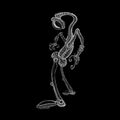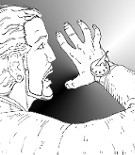Template:Selected anniversaries/October 31: Difference between revisions
From Gnomon Chronicles
No edit summary |
No edit summary |
||
| Line 22: | Line 22: | ||
||1911: Aleksander Ilyich Akhiezer born ... theoretical physicist, known for contributions to numerous branches of theoretical physics, including quantum electrodynamics, nuclear physics, solid state physics, quantum field theory, and the theory of plasma. | ||1911: Aleksander Ilyich Akhiezer born ... theoretical physicist, known for contributions to numerous branches of theoretical physics, including quantum electrodynamics, nuclear physics, solid state physics, quantum field theory, and the theory of plasma. | ||
||1914 | ||1914: John Hugenholtz born ... engineer and designer. | ||
|| | ||1919: Magnus Wenninger born ... mathematician who worked on constructing polyhedron models, and wrote the first book on their construction. Pic. | ||
|| | ||1925L John Pople born ... chemist and academic, Nobel Prize laureate. | ||
||1926 | ||1926: Harry Houdini dies ... magician and stuntman. | ||
||1935 | ||1935: Ronald Graham born ... mathematician and theorist. (Alive.) Pic. | ||
||1938 | ||1938: Great Depression: In an effort to restore investor confidence, the New York Stock Exchange unveils a fifteen-point program aimed to upgrade protection for the investing public. | ||
|| | ||1956: Francis Simon dies ... physical chemist and physicist who devised the gaseous diffusion method, and confirmed its feasibility, of separating the isotope Uranium-235 and thus made a major contribution to the creation of the atomic bomb. Pic. | ||
||1959 | ||1959: Jean Cabannes dies ... physicist and academic. | ||
||1962 | ||1962: Gabrielle Renaudot Flammarion dies ... astronomer. | ||
|| | ||1965: Jan Kowalewski dies ... Polish cryptologist, intelligence officer, engineer, journalist, military commander, and creator and first head of the Polish Cipher Bureau. He recruited a large staff of cryptologists who broke Soviet military codes and ciphers during the Polish-Soviet War, enabling Poland to weather the war and achieve victory in the 1920 Battle of Warsaw. Pic. | ||
||Elizebeth Smith Friedman | ||1980: Elizebeth Smith Friedman dies ... cryptanalyst and author, and pioneer in U.S. cryptography. She has been called "America's first female cryptanalyst". | ||
||1986 | ||1986: Robert S. Mulliken dies ... physicist and chemist, Nobel Prize laureate (b. 1896) | ||
||Raj Chandra Bose | ||1987: Raj Chandra Bose dies ... mathematician and statistician best known for his work in design theory, finite geometry and the theory of error-correcting codes in which the class of BCH codes is partly named after him. He also invented the notions of partial geometry, strongly regular graph and started a systematic study of difference sets to construct symmetric block designs. Pic. | ||
||George Eugene Uhlenbeck | ||1988: George Eugene Uhlenbeck dies ... theoretical physicist. | ||
||Theodor Schneider | ||1988: Theodor Schneider dies ... mathematician, best known for providing proof of what is now known as the Gelfond–Schneider theorem. Schneider studied from 1929 to 34 in Frankfurt; he solved Hilbert's 7th problem in his PhD thesis, which then came to be known as the Gelfond–Schneider theorem. | ||
|| | ||1992: The Vatican admitted erring for over 359 years in formally condemning Galileo Galilei for entertaining scientific truths such as the Earth revolves around the sun it, which the Roman Catholic Church long denounced as anti-scriptural heresy. After 13 years of inquiry, the Pope's commission of historic, scientific and theological scholars brought the pope a "not guilty" finding for Galileo. *TIS In 1822 the church lifted the ban on the works of Galileo and in 1979 Pope John Paul II selected a commission to investigate. On Mar 31 of 1984 the Vatican newspaper, L’Observatore Romano, stated, “The so-called heresy of Galileo does not seem to have any foundation, neither theologically nor under canon law.” It still took until Oct 31, 1992, before Pope John Paul II declared that the church may have been mistaken in condemning Galileo. *Wik | ||
|| | ||1997: Sidney Darlington dies ... electrical engineer and inventor of a transistor configuration in 1953, the Darlington pair. He advanced the state of network theory, developing the insertion-loss synthesis approach, and invented chirp radar, bombsights, and gun and rocket guidance. Pic. | ||
|| | ||2002: A federal grand jury in Houston, Texas indicts former Enron chief financial officer Andrew Fastow on 78 counts of wire fraud, money laundering, conspiracy and obstruction of justice related to the collapse of his ex-employer. | ||
|| | ||2005: Hal Anger dies ... biophysicist and engineer. | ||
|| | ||2009: Qian Xuesen dies ... aerodynamicist and academic. | ||
||2013 | ||2010: John Lewis Selfridge dies ... mathematician who contributed to the fields of analytic number theory, computational number theory, and combinatorics. | ||
||2013: Trevor Kletz dies ... chemist and author ... safety chem hazmat. | |||
File:The Eel Escapes Hydrolab.jpg|link=The Eel Escapes Hydrolab|2017: Steganographic analysis of ''[[The Eel Escapes Hydrolab]]'' reveals fifteen terabytes of encrypted data. | File:The Eel Escapes Hydrolab.jpg|link=The Eel Escapes Hydrolab|2017: Steganographic analysis of ''[[The Eel Escapes Hydrolab]]'' reveals fifteen terabytes of encrypted data. | ||
Revision as of 08:30, 31 October 2018
1815: Mathematician and academic Karl Weierstrass born. He will be cited as the "father of modern analysis".
1847: Physicist and electrical engineer Galileo Ferraris born. He will be a pioneer of AC power systems, and inventor of the induction motor.
2017: Steganographic analysis of The Eel Escapes Hydrolab reveals fifteen terabytes of encrypted data.
2018: Creature declared Image of the Day by the citizens of New Minneapolis, Canada.





